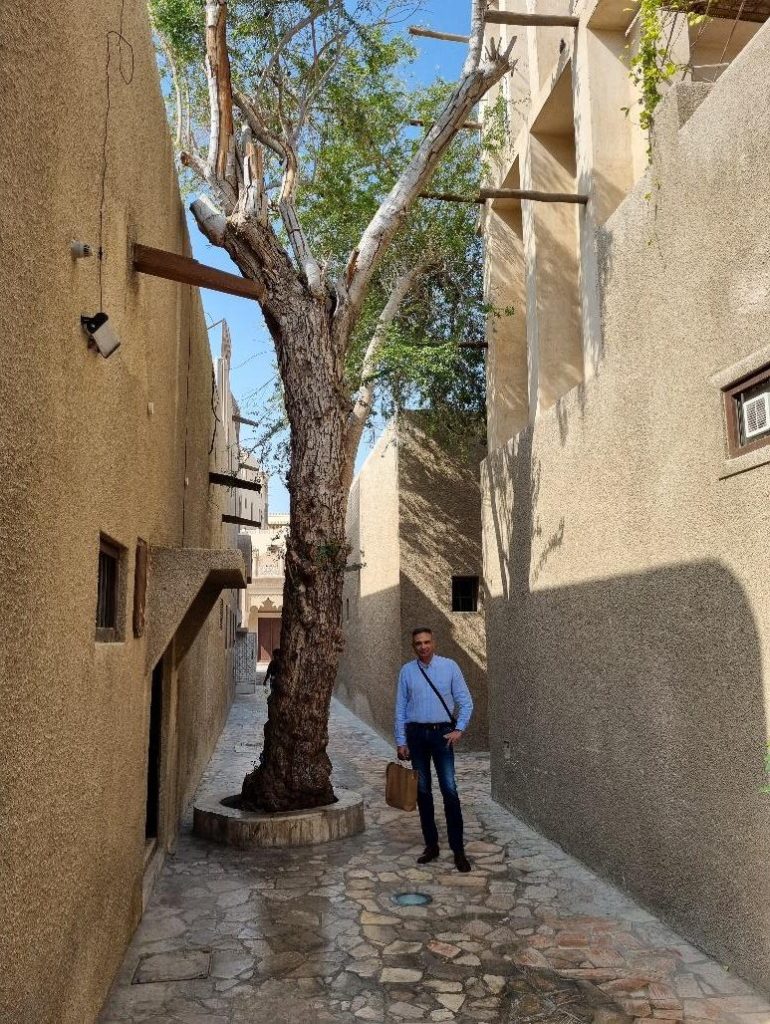The old quarter in Dubai
Of course, today’s visitors to Dubai are primarily amazed by the glamorous luxury that the city offers. There is nothing wrong with that. In such circumstances, it is easy to forget that until a few decades ago it was a city of humble fishermen and divers for pearls from the bottom of the Persian Gulf. The rapid and unexpected development of the city left no space for preserving the architectural heritage, and today’s searchers for the authentic remains of old Dubai have a difficult, but, fortunately, not an impossible task. In a strange combination of events, thanks to the unusual partnership of two lovers of classical architecture, one part of the city has preserved its original character and in it today it is possible to feel not only the spirit of old Dubai, but also of old Persia. The neighborhood, historically known as Al Bastakiya, is now officially called Al Fahidi Historical Neighborhood and is located north of most of the modern attractions, along the southern bank of Dubai Creek.
History of Al Bastakiya
The history of Al Bastakiya begins at the end of the nineteenth century when wealthy Persian merchants were attracted by the good conditions offered by the Emirate authorities, as well as by the good geographical location of Dubai, so they settled in considerable numbers along the banks of Dubai Creek, and this is how the settlement was formed with sand-colored houses in narrow winding streets, which closely resembles the cities of the Persian hot-belt. The settlement was named Bastakiya, after the southern Iranian city of Bastak. from where some of the newly arrived Persian traders originated.

A century later, in much different circumstances, in the 1980s, a part of Bastakiya was demolished for the purpose of building commercial buildings, and a decision had already been made to demolish the remaining part. The voice of opposition to such ideas was the British architect Rayner Otter, who launched a campaign with the aim of preserving that part of the city, but he would not have achieved anything if he had not found a way to attract a powerful ally, who understands enough about architecture, and whose word he would appreciate and the ruling sheikh and the circle around him. The choice of a real ally fell on Charles, Prince of Wales, heir to the British crown, who at that time had already gained a certain, albeit controversial reputation in architectural circles, advocating persistently, in accordance with his personal, elitist views, for the protection of those classical architectural values that he considered important. In this particular case, Prince Charles fully lived up to expectations and provided decisive support for the protection of the remaining part of Al Bastakiya.

At the very entrance to that old quarter of Dubai, there is an inevitable restaurant, called the Arabian Tea House, but which is much more than an ordinary Arab teahouse. It is located in a renovated, traditional, typical bourgeois house, and in it, in an unsurpassed cosmopolitan atmosphere, visitors from all continents, each with their own dress code, have a choice of several dozen teas and coffees along with numerous varieties of Arabic breakfast. That popular teahouse is just one of the manifestations of the host’s efforts to give the entire old quarter as much Arab character as possible, but it is clear, considering the way it was created, that it primarily reflects the Persian architectural tradition. For the visitor, it is an ideal opportunity to get acquainted with some of the achievements of one of the most intriguing engineering traditions – the tradition of ancient Persia.
Badgiri – Catchers of the wind
One of the most attractive manifestations of old Persian engineering from the hot climate zone are the so-called badgiri – wind catchers (bad = catcher, gir = wind). These are towers that resemble church bell towers and rise above the roofs of houses so that their top reaches the layers of faster wind, i.e. colder and cleaner air. The basic idea was that the wind enters through the openings at the top and is conducted through the tower to the central rooms of the house, bringing in a draft and slightly cooler air.

As is often the case in the Middle East, there is a fierce rivalry over which people first started making wind catchers. It seems to be Egypt after all, where similar constructions are called malqaf, but the Persian badgiri in terms of skill in design and variety of use, over time significantly surpassed the competition from Arab countries. The development of Persian wind catchers is thought to have started back in the golden age of the Persian Empire, around the 6th century BC. In the following centuries, their external appearance became established, which even today represents the most attractive element of the panorama of the old quarters of the Iranian desert cities, and especially of the city of Yazd, also known for its large Zoroastrian community. Considering that the wind catchers in Persian cities were made mainly of mud, as in Yazd, or of unbaked brick, the obligatory element were horizontal wooden sticks, which provided a certain strength, but above all served as scaffolding during frequent repairs, such as this is also the case with similar mud structures, especially in the Sahara and Sahel. Over time, these wooden elements acquired primarily a decorative character, which is certainly the case with the wind catchers in Dubai.

As the centuries passed, the ancient Persian engineers raised their towers higher and higher, then followed the actual movement of the air, overcoming problems and finding new ideas for creative uses of their structures. Some of the wind catchers actually turned against the direction of the wind, so that the air primarily comes out through them, creating air negative pressure in the house, and they were often made in pairs (input and output badgir) or as combined input and output. When there is no wind at all, the badgirs functioned like chimneys, drawing warm air into the atmosphere. At first, the openings were made only according to the prevailing wind, but later the openings were turned on all four sides with the possibility of closing some openings and with several separate vertical channels, depending on what you want to achieve and where the wind is blowing. Not only did wind catchers serve as ancient air conditioners, but they were multi-functional and could be controlled.
The most creative use of the badgir was in combination with another pearl of Persian engineering – qanats. The Persian qanat is an underground channel in which water moves in a gentle fall from the source to the city reservoir, analogous to the Roman aqueducts, but underground. Material evidence points to Persia as the place of origin of this technical invention, but it is very widespread in Arab countries and the traditional rivalry between Arabs and Iranians regarding its originality was not absent in this case either. Actually, the word qanat is Arabic, and in Iran itself, the term kariz is also used, sometimes for more complex, branched systems of underground aqueducts.
Qanats would sometimes be associated with wealthier family houses. If by using the exit badgirs, facing the opposite of the wind, there would be a real negative pressure in the house, then fresh air would come from the qanat, by sliding over the surface of the water. Due to the evaporation of the water, the air would cool down further and thus enter the house cooled. Gentlemen, it’s no longer just ventilation, it’s air conditioning.
Also, since the night temperature in the deserts is significantly lower than the daytime, the cold night air would enter the qanats and water tanks through the vertical openings and thus remain trapped and cold, until the negative pressure formed by the wind catcher would pull it into the house. Not only did the ancient Persians cool their houses in such a way, but they managed to keep water supplies in public reservoirs at temperatures close to zero until the summer months, all without using electricity and fossil fuels, but only with the energy of the sun and wind. Now that our understanding of thermodynamics and fluid mechanics is much deeper than it was in the days of the ancient Persian builders, we believe that the art of using wind catchers can be made even more efficient and successfully compete with the current electric air conditioners that are slowly destroying the planet.
Wind catchers in today’s Dubai
Wind catchers are one of the architectural elements that both Arabs and Persians are particularly proud of and are often used in modern architecture in hot cities across the Middle East, sometimes truly serving as “green air conditioners” and sometimes just as traditional decoration.

Al Bastakiya houses those authentic, original Persian badgiri, but we can see them all over the city, sometimes in unexpected places – from poor neighborhoods inhabited by hard-working Indian and Pakistani workers, to wealthy mansions where wind catchers are just an ornament to show their owners their respect. according to the architectural tradition.

Darko Veselinović, June 2022.

